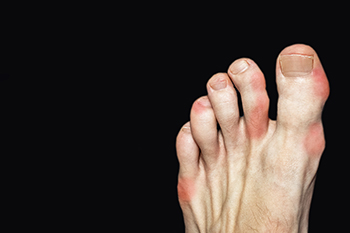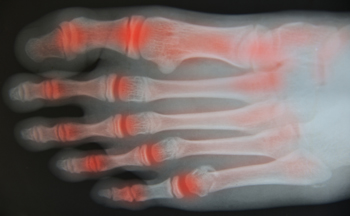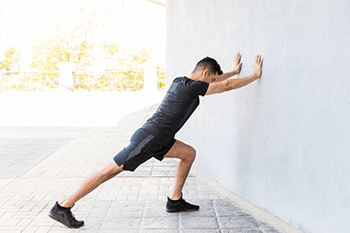

While a common cause of heel pain is plantar fasciitis, treatment options for relief may vary. Plantar fasciitis is an inflammation of the band of tissue on the sole of the foot that runs from the bottom of the toes to the heel. It is an overuse injury and is especially common among runners. With every step the plantar fascia contracts and then stretches, which can cause tiny tears in the tissue nearest the heel bone. The area then becomes inflamed and painful. Corticosteroid injections are a common treatment option for plantar fasciitis because they help to reduce the inflammation. However, steroids may also weaken the fatty pads under the heel, which in some cases results in chronic pain. A number of non-invasive treatments are thought to help reduce the effects of plantar fasciitis in those who do not respond to exercises and stretching. Among them are shock wave therapy and ultrasound therapy. If you have questions about treatment options, please consult a podiatrist for more information.
Plantar fasciitis can be very painful and inconvenient. If you are experiencing heel pain or symptoms of plantar fasciitis, contact Dr. Todd Goldberg from Complete Family Foot Care Center. Our doctor can provide the care you need to keep you pain-free and on your feet.
What Is Plantar Fasciitis?
Plantar fasciitis is the inflammation of the thick band of tissue that runs along the bottom of your foot, known as the plantar fascia, and causes mild to severe heel pain.
What Causes Plantar Fasciitis?
How Can It Be Treated?
While very treatable, plantar fasciitis is definitely not something that should be ignored. Especially in severe cases, speaking to your doctor right away is highly recommended to avoid complications and severe heel pain. Your podiatrist can work with you to provide the appropriate treatment options tailored to your condition.
If you have any questions please feel free to contact our office located in Littlestown, PA . We offer the newest diagnostic and treatment technologies for all your foot and ankle needs.

Severe pain, swelling, and redness surrounding the joint in the big toe can be indicative gout. It is a form of arthritis, and it can come from genetic factors or from eating foods that are high in purine levels. Elevated levels of purine can produce uric acid, and form crystals that can build up in the joints of the big toe. Some foods that have large amounts of purines include red meat, shellfish, and drinks that are made with large amounts of sugar. Additionally, people who are overweight, have high blood pressure, or who are diabetic may be prone to getting gout. This condition occurs in flare-ups and can last up to a week. Chronic gout may cause loss of mobility and joint damage. There are effective preventative methods that may help to control the onset of gout. These can consist of incorporating a healthy diet into your daily routine, performing simple exercise programs, and maintaining an acceptable weight. If you suffer from gout, it is strongly suggested that you are under the care of a podiatrist who can help you with additional prevention and treatment options.
Gout is a foot condition that requires certain treatment and care. If you are seeking treatment, contact Dr. Todd Goldberg from Complete Family Foot Care Center. Our doctor will treat your foot and ankle needs.
What Is Gout?
Gout is a type of arthritis caused by a buildup of uric acid in the bloodstream. It often develops in the foot, especially the big toe area, although it can manifest in other parts of the body as well. Gout can make walking and standing very painful and is especially common in diabetics and the obese.
People typically get gout because of a poor diet. Genetic predisposition is also a factor. The children of parents who have had gout frequently have a chance of developing it themselves.
Gout can easily be identified by redness and inflammation of the big toe and the surrounding areas of the foot. Other symptoms include extreme fatigue, joint pain, and running high fevers. Sometimes corticosteroid drugs can be prescribed to treat gout, but the best way to combat this disease is to get more exercise and eat a better diet.
If you have any questions please feel free to contact our office located in Littlestown, PA . We offer the newest diagnostic and treatment technologies for all your foot and ankle needs.

Rheumatoid arthritis can be a debilitating disease where a joint's lining (synovium) is attacked by the body’s immune system. This causes the synovium to become inflamed, which damages the surrounding tissues and ligaments. In time, this may dislocate toe joints and cause deformities such as bunions and hammertoes. Along with toe joints, rheumatoid arthritis can also occur in the ankle joint, the tarsometatarsal joints in the midfoot, and the hindfoot (heel area). While rheumatoid arthritis has no cure, a podiatrist can help treat its symptoms which, if left untreated, may inhibit a person’s ability to lead a normal life. Your podiatrist may prescribe special shoes, braces, and/or create custom orthotics to help restore functionality to the feet and ankles and relieve pain. Icing, gentle exercises, and physical therapy may also help relieve symptoms, as can corticosteroid injections. Make an appointment with a podiatrist today to begin treatment for your painful rheumatoid arthritis symptoms.
Because RA affects more than just your joints, including the joints in your feet and ankles, it is important to seek early diagnosis from your podiatrist if you feel like the pain in your feet might be caused by RA. For more information, contact Dr. Todd Goldberg of Complete Family Foot Care Center. Our doctor will assist you with all of your podiatric concerns.
What Is Rheumatoid Arthritis?
Rheumatoid Arthritis (RA) is an autoimmune disorder in which the body’s own immune system attacks the membranes surrounding the joints. Inflammation of the lining and eventually the destruction of the joint’s cartilage and bone occur, causing severe pain and immobility.
Rheumatoid Arthritis of the Feet
Although RA usually attacks multiple bones and joints throughout the entire body, almost 90 percent of cases result in pain in the foot or ankle area.
Symptoms
Diagnosis
Quick diagnosis of RA in the feet is important so that the podiatrist can treat the area effectively. Your doctor will ask you about your medical history, occupation, and lifestyle to determine the origin of the condition. Rheumatoid Factor tests help to determine if someone is affected by the disease.
If you have any questions please feel free to contact our office located in Littlestown, PA . We offer the newest diagnostic and treatment technologies for all your foot and ankle needs.

The Achilles tendon is considered to be the thickest and strongest tendon in the body. It connects the calf muscles to the heel and enables the patient to point and flex the foot. The Achilles tendon can become injured in an accident or due to improper warming up and cooling down before exercising. Some of the symptoms associated with an Achilles tendon injury can consist of heel pain while running and the back of the calf may feel stiff and tight. It is important to stop running when this type of injury occurs, as ample time is needed for the tendon to heal. It may be beneficial to perform stretches that can help to improve flexibility and range of motion of the Achilles tendon. An effective exercise is known as the eccentric heel drop. This is practiced by standing on a step and lowering the heel until a gentle stretch is felt. It can also be done facing a wall like the picture shows. If you have incurred an Achilles tendon injury it is strongly advised that you confer with a podiatrist who can offer you the correct treatment options.
Achilles tendon injuries need immediate attention to avoid future complications. If you have any concerns, contact Dr. Todd Goldberg of Complete Family Foot Care Center. Our doctor can provide the care you need to keep you pain-free and on your feet.
What Is the Achilles Tendon?
The Achilles tendon is a tendon that connects the lower leg muscles and calf to the heel of the foot. It is the strongest tendon in the human body and is essential for making movement possible. Because this tendon is such an integral part of the body, any injuries to it can create immense difficulties and should immediately be presented to a doctor.
What Are the Symptoms of an Achilles Tendon Injury?
There are various types of injuries that can affect the Achilles tendon. The two most common injuries are Achilles tendinitis and ruptures of the tendon.
Achilles Tendinitis Symptoms
Rupture Symptoms
Treatment and Prevention
Achilles tendon injuries are diagnosed by a thorough physical evaluation, which can include an MRI. Treatment involves rest, physical therapy, and in some cases, surgery. However, various preventative measures can be taken to avoid these injuries, such as:
If you have any questions please feel free to contact our office located in Littlestown, PA . We offer the newest diagnostic tools and technology to treat your foot and ankle needs.